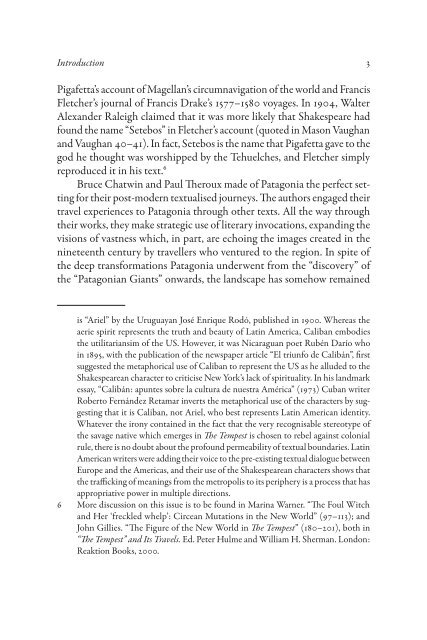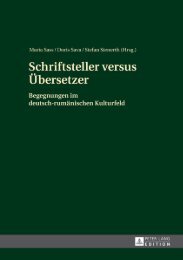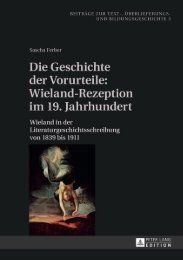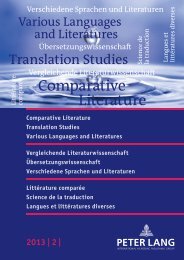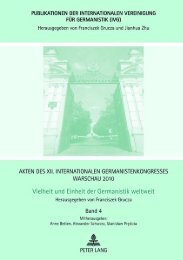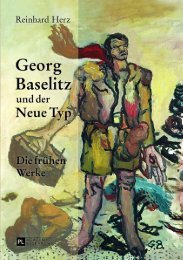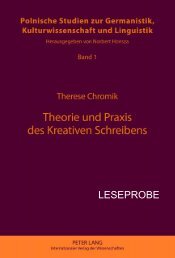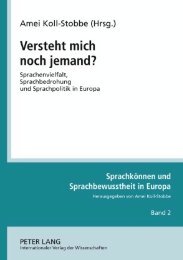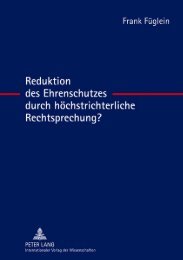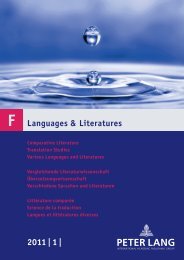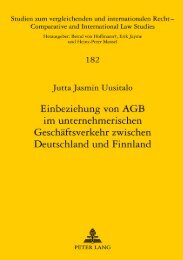Extract (PDF) - Peter Lang
Extract (PDF) - Peter Lang
Extract (PDF) - Peter Lang
Create successful ePaper yourself
Turn your PDF publications into a flip-book with our unique Google optimized e-Paper software.
Introduction 3<br />
Pigafetta’s account of Magellan’s circumnavigation of the world and Francis<br />
Fletcher’s journal of Francis Drake’s 1577–1580 voyages. In 1904, Walter<br />
Alexander Raleigh claimed that it was more likely that Shakespeare had<br />
found the name “Setebos” in Fletcher’s account (quoted in Mason Vaughan<br />
and Vaughan 40–41). In fact, Setebos is the name that Pigafetta gave to the<br />
god he thought was worshipped by the Tehuelches, and Fletcher simply<br />
reproduced it in his text.6<br />
Bruce Chatwin and Paul Theroux made of Patagonia the perfect setting<br />
for their post-modern textualised journeys. The authors engaged their<br />
travel experiences to Patagonia through other texts. All the way through<br />
their works, they make strategic use of literary invocations, expanding the<br />
visions of vastness which, in part, are echoing the images created in the<br />
nineteenth century by travellers who ventured to the region. In spite of<br />
the deep transformations Patagonia underwent from the “discovery” of<br />
the “Patagonian Giants” onwards, the landscape has somehow remained<br />
is “Ariel” by the Uruguayan José Enrique Rodó, published in 1900. Whereas the<br />
aerie spirit represents the truth and beauty of Latin America, Caliban embodies<br />
the utilitariansim of the US. However, it was Nicaraguan poet Rubén Darío who<br />
in 1895, with the publication of the newspaper article “El triunfo de Calibán”, first<br />
suggested the metaphorical use of Caliban to represent the US as he alluded to the<br />
Shakespearean character to criticise New York’s lack of spirituality. In his landmark<br />
essay, “Calibán: apuntes sobre la cultura de nuestra América” (1973) Cuban writer<br />
Roberto Fernández Retamar inverts the metaphorical use of the characters by suggesting<br />
that it is Caliban, not Ariel, who best represents Latin American identity.<br />
Whatever the irony contained in the fact that the very recognisable stereotype of<br />
the savage native which emerges in The Tempest is chosen to rebel against colonial<br />
rule, there is no doubt about the profound permeability of textual boundaries. Latin<br />
American writers were adding their voice to the pre-existing textual dialogue between<br />
Europe and the Americas, and their use of the Shakespearean characters shows that<br />
the trafficking of meanings from the metropolis to its periphery is a process that has<br />
appropriative power in multiple directions.<br />
6 More discussion on this issue is to be found in Marina Warner. “The Foul Witch<br />
and Her ‘freckled whelp’: Circean Mutations in the New World” (97–113); and<br />
John Gillies. “The Figure of the New World in The Tempest” (180–201), both in<br />
“The Tempest” and Its Travels. Ed. <strong>Peter</strong> Hulme and William H. Sherman. London:<br />
Reaktion Books, 2000.


